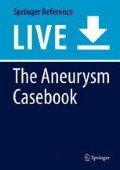Abstract
Cerebral vasospasm represents one of the most severe complications of subarachnoid hemorrhage (SAH) and consists of the progressive narrowing of intracranial arteries in the acute and subacute phase after the bleeding. The window of time in which the patient is at the highest risk of vasospasm is between day 6 and day 14 after the ictus. The medical management of posthemorrhagic vasospasm, as recommended by the American Heart Association, consists of induced arterial hypertension. In refractory cases or in patients with cardiovascular contraindications for induced hypertension, endovascular treatment with balloon angioplasty or intra-arterial infusion of a vasodilator is recommended (IIa). This treatment is suitable for proximal and focal vasospasm. In this chapter, we discuss the case of a 64-year-old woman who presented with a spontaneous SAH due to the rupture of a paraophthalmic aneurysm. Focal proximal vasospasm was treated with different endovascular techniques. For a diffuse distal vasospasm, a NeuroFlo device was used with good angiographic and clinical outcomes. The treatment of posthemorrhagic vasospasm in general and the use of the NeuroFlo device in particular are the main topics of this chapter.
References
Abruzzo T, Moran C, Blackham KA, Eskey CJ, Lev R, Meyers P, Narayanan S, Prestigiacomo CJ. Invasive interventional management of post-hemorrhagic cerebral vasospasm in patients with aneurysmal subarachnoid hemorrhage. J Neurointerv Surg. 2012;4(3):169–77. https://doi.org/10.1136/neurintsurg-2011-010248.
Bernardini GL, Schellinger PD, Abou-Chebl A, Cockroft K, Shuaib A, Sheorajpanday R, Sen S, Diener HC, Leker RR, Bornstein NM. Efficacy of NeuroFlo device in treatment of patients with atrial fibrillation. J Stroke Cerebrovasc Dis. 2014;23(6):1457–61. https://doi.org/10.1016/j.jstrokecerebrovasdis.2013.12.006.
Clark JF, Sharp FR. Bilirubin oxidation products (BOXes) and their role in cerebral vasospasm after subarachnoid hemorrhage. J Cereb Blood Flow Metab. 2006;26(10):1223–33. https://doi.org/10.1038/sj.jcbfm.9600280.
Connolly ES Jr, Rabinstein AA, Carhuapoma JR, Derdeyn CP, Dion J, Higashida RT, Hoh BL, Kirkness CJ, Naidech AM, Ogilvy CS, Patel AB, Thompson BG, Vespa P; American Heart Association Stroke Council; Council on Cardiovascular Radiology and Intervention; Council on Cardiovascular Nursing; Council on Cardiovascular Surgery and Anesthesia; Council on Clinical Cardiology Guidelines for the management of aneurysmal subarachnoid hemorrhage: a guideline for healthcare professionals from the American Heart Association/American Stroke Association. Stroke 2012 43(6):1711-1737. https://doi.org/10.1161/STR.0b013e3182587839.
Dorsch NW, King MT. A review of cerebral vasospasm in aneurysmal subarachnoid haemorrhage Part I: incidence and effects. J Clin Neurosci. 1994;1(1):19–26.
Ecker A, Riemenschneider PA. Arteriographic demonstration of spasm of the intracranial arteries, with special reference to saccular arterial aneurysms. J Neurosurg. 1951;8(6):660–7. https://doi.org/10.3171/jns.1951.8.6.0660.
Ekelund A, Reinstrup P, Ryding E, Andersson AM, Molund T, Kristiansson KA, Romner B, Brandt L, Säveland H. Effects of iso- and hypervolemic hemodilution on regional cerebral blood flow and oxygen delivery for patients with vasospasm after aneurysmal subarachnoid hemorrhage. Acta Neurochir. 2002;144(7):703–12; discussion 712-3. https://doi.org/10.1007/s00701-002-0959-9.
Findlay JM, Nisar J, Darsaut T. Cerebral vasospasm: a review. Can J Neurol Sci. 2016;43(1):15–32. https://doi.org/10.1017/cjn.2015.288.
Jun P, Ko NU, English JD, Dowd CF, Halbach VV, Higashida RT, Lawton MT, Hetts SW. Endovascular treatment of medically refractory cerebral vasospasm following aneurysmal subarachnoid hemorrhage. AJNR Am J Neuroradiol. 2010;31(10):1911–6. https://doi.org/10.3174/ajnr.A2183.
Kerz T, Boor S, Ulrich A, Beyer C, Hechtner M, Mueller-Forell W. Endovascular therapy for vasospasm after aneurysmatic subarachnoid hemorrhage. Br J Neurosurg. 2016;30(5):549–53. https://doi.org/10.3109/02688697.2016.1173193.
Laidlaw JD, Siu KH. Aggressive surgical treatment of elderly patients following subarachnoid haemorrhage: management outcome results. J Clin Neurosci. 2002;9(4):404–10.
Lennihan L, Mayer SA, Fink ME, Beckford A, Paik MC, Zhang H, Wu YC, Klebanoff LM, Raps EC, Solomon RA. Effect of hypervolemic therapy on cerebral blood flow after subarachnoid hemorrhage: a randomized controlled trial. Stroke. 2000;31(2):383–91.
Lylyk P, Vila JF, Miranda C, Ferrario A, Romero R, Cohen JE. Partial aortic obstruction improves cerebral perfusion and clinical symptoms in patients with symptomatic vasospasm. Neurol Res. 2005;27(Suppl 1):S129–35. https://doi.org/10.1179/016164105X35512.
Park ES, Kim DW, Kang SD. Endovascular treatment of symptomatic vasospasm after aneurysmal subarachnoid hemorrhage: a three-year experience. J Cerebrovasc Endovasc Neurosurg. 2017;19(3):155–61. https://doi.org/10.7461/jcen.2017.19.3.155.
Pluta RM. Delayed cerebral vasospasm and nitric oxide: review, new hypothesis, and proposed treatment. Pharmacol Ther. 2005;105(1):23–56. https://doi.org/10.1016/j.pharmthera.2004.10.002.
Rosen CL, Sekhar LN, Duong DH. Use of intra-aortic balloon pump counterpulsation for refractory symptomatic vasospasm. Acta Neurochir. 2000;142(1):25–32.
Shuaib A, Bornstein NM, Diener HC, Dillon W, Fisher M, Hammer MD, Molina CA, Rutledge JN, Saver JL, Schellinger PD, Shownkeen H, SENTIS Trial Investigators. Partial aortic occlusion for cerebral perfusion augmentation: safety and efficacy of NeuroFlo in Acute Ischemic Stroke trial. Stroke. 2011;42(6):1680–90. https://doi.org/10.1161/STROKEAHA.110.609933.
Terry A, Zipfel G, Milner E, Cross DT 3rd, Moran CJ, Diringer MN, Dacey RG Jr, Derdeyn CP. Safety and technical efficacy of over-the-wire balloons for the treatment of subarachnoid hemorrhage-induced cerebral vasospasm. Neurosurg Focus 2006;21(3):E14.
Zabramski JM, Spetzler RF, Bonstelle C. Chronic cerebral vasospasm: effect of volume and timing of hemorrhage in a canine model. Neurosurgery. 1986;18(1):1–6.
Zhang ZD, Yamini B, Komuro T, Ono S, Johns L, Marton LS, Weir B, Macdonald RL. Delayed clot removal and experimental vasospasm. Acta Neurochir Suppl. 2001;77:33–5.
Zwienenberg-Lee M, Hartman J, Rudisill N, Muizelaar JP. Endovascular management of cerebral vasospasm. Neurosurgery. 2006;59(5 Suppl 3):S139–47; discussion S3-13. https://doi.org/10.1227/01.NEU.0000239252.07760.59.
Author information
Authors and Affiliations
Corresponding author
Editor information
Editors and Affiliations
Rights and permissions
Copyright information
© 2019 Springer Nature Switzerland AG
About this entry
Cite this entry
Lylyk, I., Bleise, C., Viso, R., Scrivano, E., Lylyk, P. (2019). Paraophthalmic Internal Carotid Artery Aneurysm: Spontaneous Subarachnoid Hemorrhage Caused by the Rupture of a Paraophthalmic Aneurysm, Treated with Coils and Complicated by Severe Vasospasm, Treated with Pharmaceutical Vessel Dilatation and Proximal Balloon Angioplasty; Diffuse Distal Vasospasm Treated with the NeuroFlo Device with Good Clinical Outcome. In: Henkes, H., Lylyk, P., Ganslandt, O. (eds) The Aneurysm Casebook. Springer, Cham. https://doi.org/10.1007/978-3-319-70267-4_119-1
Download citation
DOI: https://doi.org/10.1007/978-3-319-70267-4_119-1
Received:
Accepted:
Published:
Publisher Name: Springer, Cham
Print ISBN: 978-3-319-70267-4
Online ISBN: 978-3-319-70267-4
eBook Packages: Springer Reference MedicineReference Module Medicine

